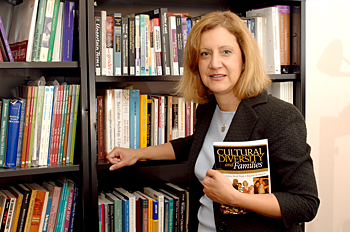
No wonder the most important point UD's Bahira Sherif Trask wants to make about all this is that cultural diversity is a very complex, multi-layered issue.
“The impetus for the book was that I really did not like the way cultural diversity gets discussed in the U.S.,” the associate professor of individual and family studies, said. “In the U.S. diversity equals race and, really, it's much more complicated than that.”
That's the theory behind the new, fast-selling book, Cultural Diversity and Families, that Trask edited with Raeann R. Hamon of Messiah College. Several members of the UD faculty, staff and alumni contributed chapters.
Trask explained that most literature on the subject of cultural diversity and families approaches the topic by presenting the characteristics, practices and values of specific racial or ethnic groups as immutable facts that do not change over time or place. Intragroup variability and the dynamics of relationships between individuals and their cultural contexts is often overlooked. Trask's book organizes information in a new fashion--it looks at broad issues that affect culturally diverse families instead of organizing the information by racial or ethnic groups.
“We forget that all cultures have overlapping concerns,” Trask said. “For example, all families care about their children. We forget that when we stereotype Chinese-American families as being 'the ones' that stress education. All parents want a safe environment and a good education for their children.
“Or, for example, when we generalize that low-income families have more female heads of households and talk about 'one more mouth to feed' we forget that there is generally a lack of eligible, employed men for these women to marry--that these women may not be single by choice. And, we forget that divorce is always a very complicated process. Divorce cannot be simplistically equated with cultural reasons.
Cultural diversity touches everyone, Trask said, adding, it's critical to be aware of other parts of the world and to keep that in mind as we interact with others on a daily basis.
“Every year in my classes I ask my students to work on an internationally-based project. Part of the project includes interviewing someone from another country. Interestingly, they all are able to find someone without difficulty. No one ever says they can't find anyone. The world has been globalized through computer technology and mass transportation. It is critical that we be aware of and sensitive to other cultures and other parts of the world.
In order to be truly sensitive to others we cannot ascribe a list of traits or characteristics to those who come from different backgrounds than ourselves. We need to be aware of variability based on multiple factors including class, education, socio-historical time and individual experience. We do need to be aware that other's worldviews may be quite different. For example, I like to tell my students that one day they may have a new boss who could be from India or from Japan. It is important to realize that that person may look at the world quite differently, for example, with respect to gender relations.
Cultural Diversity and Families addresses the complex issue of heterogeneity in US society in three sections. The first section focuses on past research on this topic and highlights the fact that most research on families has been conducted on white suburban middle class families. This has skewed research findings on culturally diverse families, often times presenting them as deviant or chaotic. In this section Trask co-authored a chapter on theoretical and methodological approaches. Pearl Stewart, '86 CHEP, '03Ph.D./CHEP, assistant professor of family and child studies at Montclair State, co-authored the chapter on “Historical Trends in the Study of Diverse Families.”
The second section of the book looks at specific issues affecting life in culturally diverse families. “By focusing on experiences that are shared by all families such as gender issues, economics, marital relationships, childrearing, work-family and intergenerational relationships and aging, we emphasize commonalities among families,” Trask said.
In this second section, Trask co-authored a chapter on “Trends in Marriage and Co-habitation,” with Julie Koivunen, '05Ph.D., CHEP, an assistant professor in human development and family studies at the University of Wisconsin-Stout. The chapter “Women, Work and Families: Learning Experiences in Social Contexts” was authored by UD alumni Seongeun Kim, '02PhD./CHEP and Tara Woolfolk, '88M, '02Ph.D./CHEP. Kim is now is now an assistant professor of human development and families studies at Pennsylvania State University, Delaware County, and Woolfolk is a research associate in UD's Department of Individual and Family Studies.
The third section of the book, “Contextual Issues and Culturally Diverse Families,” includes a chapter on “Human Services and Cultural Diversity: Tenuous Relationships, Challenges, and Opportunities Ahead” authored by Donald Unger, UD professor of Individual and Family Studies; Teresita Cuevas, 02M/CHEP, a graduate of the UD MPA program and a research associate in the UD Center for Disabilities Studies; and Woolfolk.
In choosing authors for the various topics, Trask said she looked for a variety of contributors including scholars of culturally diverse backgrounds, well known professionals in the field of family studies, new scholars, and several practitioners. The book was published by SAGE Publications, the leading publisher in the field of family studies, and is available at Amazon.com.
Article by Beth Thomas
Photo by Kathy Atkinson


